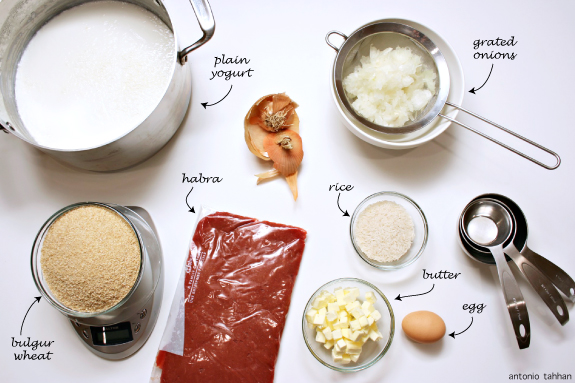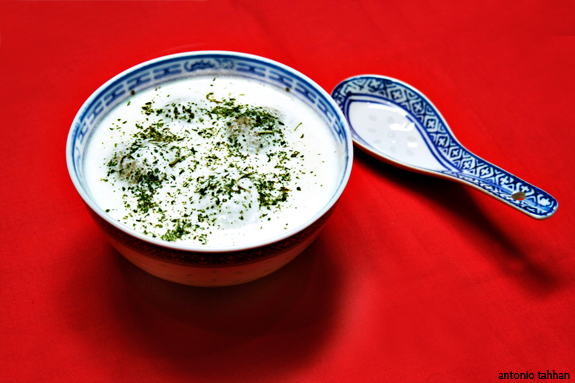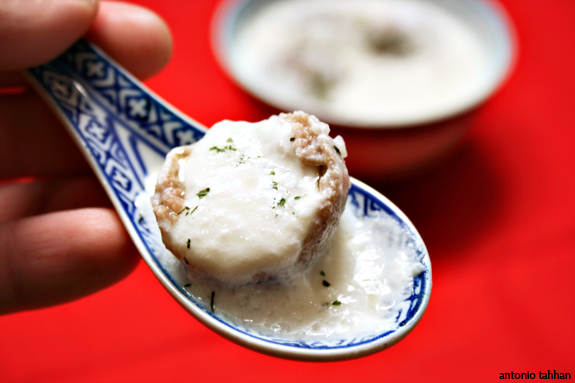It’s almost February, it’s cold and it’s the perfect time for soup, if there ever was one. Keeping true to my kibbeh promise from my last post, I made kibbeh b’laban (كبة بلبن او كبة لبنية), which literally translated means kibbeh cooked in yogurt. Not only was it my first try at making this on my blog, but it was my first attempt ever. In order to get everything right, I called my sito (grandmother in Arabic) and stayed on the phone with her until I got every last detail of this dish right. It also took a long time since I had to convert her measurements of “handfuls, half-handfuls and pinches” into more relative quantities. All in all, it was lots of fun and in retrospect, a major success.

If you want to go for the absolute traditional method, you’ll want to use goat milk yogurt instead of cow’s milk. Although either works fine for this dish. The other main ingredient I want to talk about is the habra, which is basically ground inside round (with absolutely no fat) and then processed in the food processor with some salt, a little ice water and a tiny amount of baking soda. This makes the traditional meat paste used in every kibbeh recipe. I’ll usually prepare kilos of habra at a time and keep 500g portions stored in the freezer for whenever I want to make kibbeh.

The meat itself has absolutely no fat, and is mixed with the soaked bulgur wheat to form the outside of the kibbeh balls. For moisture, the kibbeh is stuffed with grated onions and a tiny dab of cold butter. As the kibbeh balls cook in the yogurt, the butter will melt and combine with the grated onions to make for a sweet surprise in each bite.

The yogurt is the foundation of the dish and requires some cleverness to avoid it from curdling over the heat. The first step is to cook about a quarter cup of rice in 3/4 to 1 cup of water (way more than you usually need) until it turns into complete mush. Once it cools a bit you’ll want to blend the mushy rice with the yogurt, egg and a teaspoon of cornstarch. The egg, cornstarch and rice all act as stabilizers for the yogurt. A final precaution would be to cook the sauce over low heat and stirring only in one direction (either clockwise or counterclockwise). Don’t ask me why, but it works… if anyone knows a more scientific reason to this, I’d love to know it.

Once the yogurt begins to simmer, cook the kibbeh balls in the yogurt at a low simmer for about 7-10 minutes (depending on the size of your kibbeh) and you’ve got a fantastic Middle Eastern soup. Sprinkle with some dried mint and enjoy.
Kibbeh B’Laban
4-6 servings
Components
- 500 g. habra
- 300 g. bulgur wheat (finely ground)
- 1 large onion, grated
- 1/2 stick of butter, cut into tiny cubes
- 2 liters of goat or cow yogurt
- 1/4 cup rice
- 1 tsp of cornstarch
- 1 egg
- dried mint, for garnish
- 1/2 tsp ground allspice
- ice cold water, as necessary*
Putting them all together
- Soak the bulgur wheat in water for 10-15 minutes (use enough water to cover the bulgur entirely by about 1/4 inch).
- Mix habra, allspice and soaked bulgur together and set aside.
- Cook the rice in 3/4 cup of water until mushy.
- Blend the rice with some of the yogurt, the egg and the cornstarch. Mix this mixture with the rest of yogurt and place over low heat.
- Stir occasionally and once it comes to a small simmer, add kibbeh balls and cook for another 5-10 minutes (depending on the size of the kibbeh).
- Garnish with dried mint.
note: use the ice water to form the kibbeh balls. This will help make them smooth. For more specific step-by-step instructions read the blog post.

What a lovely, different and refreshing soup Tony. The yogurt is a nice touch.
That looks delicious Tony!
Mmmmmm! What a different soup! Not the kind I’m used to but I would love to try :D. It’s so exotic!
What would we do without our grandmothers?
I love Kibbeh, funnily enough I’ve just blogged about using them with pomegranate soup (ashe-e-anar) and I love the idea of using a yogurt sauce too.
http://culinarytravelsofakitchengoddess.wordpress.com/2009/01/29/eat/
Your blog is inspirational btw 🙂
Tony, this is awesome stuff…never saw this before and I’m so curious to try this. Love the Habra ingredient too!
Oh, wow, cool. This is so different from anything I’ve seen. That butter and onions wrapped up inside the meat sounds really good.
Yeslamo dayyatak ya Tony! This looks delicious. I prefer laban soup without rice in it. Two ways to go about this without it curdling. 1) What my sito and mama do, and what u said too: just keep stirring 1 package of yogurt with equal parts water and 1 egg from the second you put them on the heat until it starts simmering. It takes forever and you damn near break an arm, but it works everytime. Once it starts simmering, you’re safe and it never curdles. Or 2) What I found out works best with the creamiest results and never curdles: same exact ingredients I just mentioned, and shake that baby up with a hand immersion blender! Let it simmer, and give it another couple of blends while it cooks. Cook the soup for about 30 minutes till it thickens up a bit. If you’re not making it with kubbeh and want to have it as a soup, a meaty lamb bone added while the soup is simmering will give it a nice flavor.
Thats all. Great post 😀
Nice recipe and you listed it in details! thanks for sharing.
when i cook yogurt i only add corn starch to it, and it works out every single time…i find it a little complicated to add the mushy rice and the egg to it to stabilize it.
have you checked my kibbeh video recipes? http://mimicooks.com/2009/01/kebbeh-kibbeh.html
I’ve been thought to do it with “shahhmeh” filling mixed with our arabic spices and salt. If my mom was out of shahhmeh she would use butter instead, but again no onions with it. since i don’t like rice with laban, mom boils chicken and uses the water to cook the kebbe and add the (allepo-made) yougurt to it.amazing..
I’ve never come across this before, but I’m fascinated. I love the idea of finding the little parcel of buttery onions in the centre of each parcel!
Oh my, that looks so delicious! And simple too. Neat trick with using the rice to stabilize the yogurt.
I love this dish, its actually one of my favorites, I would like to ask you, some people add garlic to this recipe, how can I add the garlic without the yoghurt curdling?? Thanks a lot for leaving this type of recipes.
I love this dish and I’ve been looking for a recipe! My old roommate is Lebanese and his mother didn’t translate all the recipes that I loved. Thank you!!!
Toni, I want to thank you foryourblog. I’m 42 married 22 years and a pretty good cook. I’m a working parent and my kids keep me veryveyr busy. My daughter came home for her first semseter of college craving various middle eatren foods (we are from syria) some I forgot how to make. Her fav. id kibbeh B’Laban so I being the great mother searched the web abd came across your blog and you saved my life……The best receipes are here on your blog!!!!!! Thank you sooooooo much and happy new year Toni!!!!!!
Tony,
Am from Aleppo and we always made kibbeh labanieh but the kibbeh was always stuffed with meat, onion and pine nuts…. yours sounds easier 🙂
marhaba Samira 🙂 thanks for the comment.
I’ve heard of three ways of stuffing kibbeh for kibbeh labaniyeh:
1) with shahme (شحمة), usually sheep fat — this is hearty, delicious, but very, very heavy, in my opinion.
2) meat, onion and pine nuts, like you mentioned, is another traditional method.
3) cubes of butter — more recently I’ve seen this being done as a way to retain the richness of the shahme, without it being so heavy on the stomach.
I haven’t heard of many Aleppans that add grated onion into their kibbeh for labaniyeh… I learned this from my grandmother. I love the taste the onions add to the dish.
WOW! I’ve been looking for a similar recipe that my grandfather brought over from ‘the old country’ in the early 1900’s. I grew up eating this – which we called Koobie Ball soup. I think that my grandmother used buttermilk to make the yogurt soup; but this is as close as I’ve seen to what I used to eat as a child. Thanks for posting this recipe!
My father was Syrian, my mother Austrian. She spoke fluent Arabic & (she spoke 6 languages). cooked almost all Syrian food cause that’s what we loved.Sometimes she added her own twist& the Syrian women at St.George always asked for her recipe. Anyhow she didn’t make this cause my dad didn’t care for it but it looks yummy so I’ll give it a try. She made what we called kibbee in dablee soup. Excuse the spelling. She made the kibbee balls stuffed with very cold butter,black pepper,& onions. Put rice & water& a quartered onion salt & pepper & Tbsp.or two of clarified butter in a pot.When it came to a boil she added the kibbee & put it on simmer till kibbee & rice was cooked delish. She also always made her own fillo dough from scratch. We would tease her about really being Syrian.Miss her & miss her cooking. I usually make everything the way she did but sometimes it’s a hit & miss since she used no recipes & only measured with a coffee mug. She made the best Syrian bread(not pita bread.